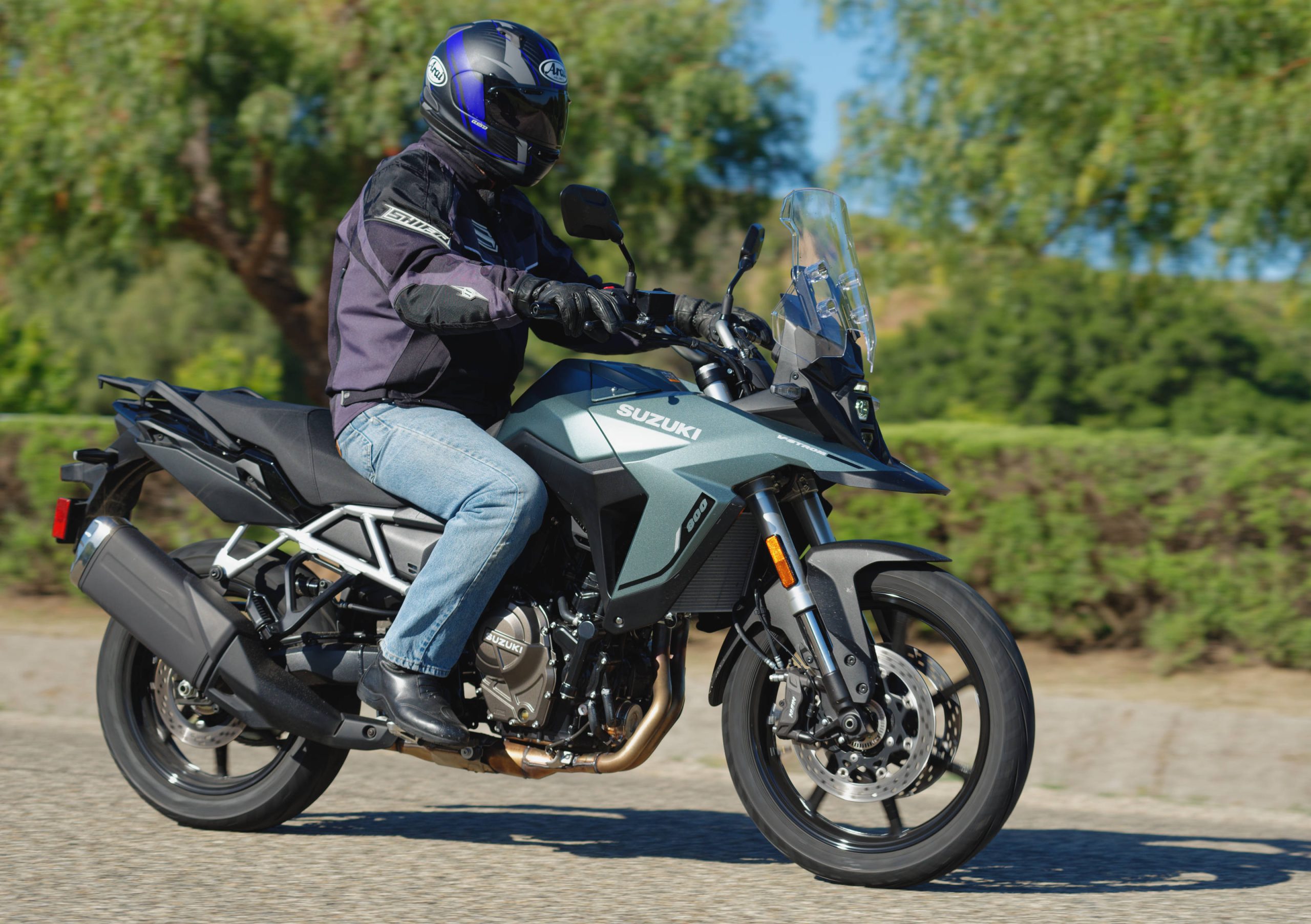
Suzuki’s 776cc parallel twin engine introduced a couple of years ago is, by all accounts, a gem. MD had never sampled a bike with this engine until we picked up our V-Strom 800 test unit a couple of months ago. It turns out that the engine is a gem, and so is the rest of this bike.
MD has more than its share of experience riding adventure bikes modified to serve primarily as a street machine. You may recall that editor Edge modified his personal KTM 790 Adventure by, among several other things, installing a 19″ front wheel and 17″ rear in place of the 21/18 stock units. This allowed the use of sport touring rubber. The goal was to create a pure street machine with the comfortable upright ergonomics and wind protection of an adventure bike. This was somewhat successful with some shortcomings.
Getting the 790 Adventure to work properly as a street bike involved more work than anticipated. In addition to needing new tone rings to get the speedometer and ABS to work properly with the change in wheel sizes, the width of the wheels and tires installed on the 19/17 rims needed to be reduced to dial-in the handling. The front brake also needed some work (specifically, more aggressive pads).
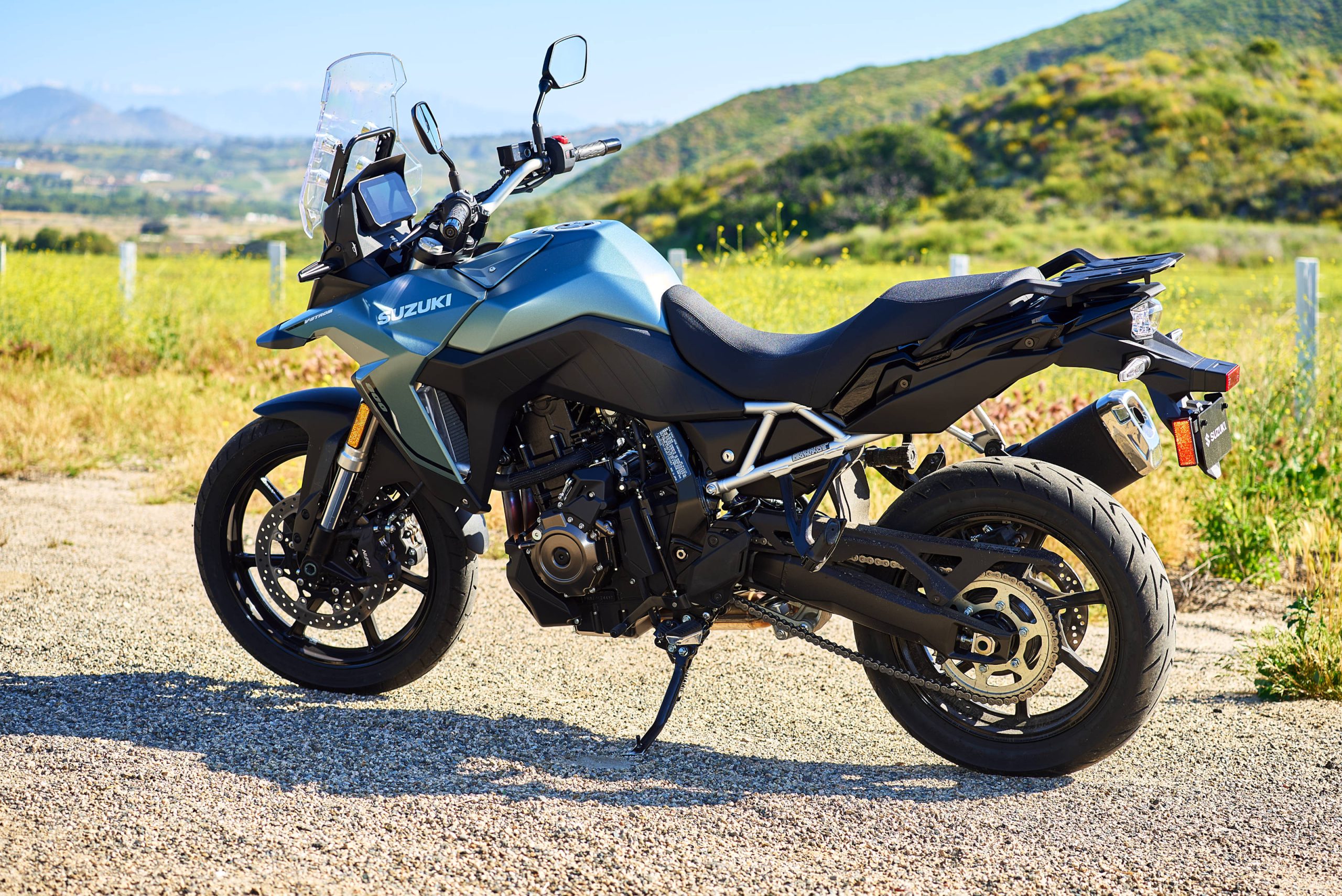
So I rode and tested the V-Strom 800 with much more than mild curiosity. This was a direct competitor to what I had been trying to build with the KTM. Not surprisingly, perhaps, the Suzuki worked far better on the street than my modified adventure bike ever did.
Let’s start by talking about some technical specifications. The V-Strom 800 is not the lightest middleweight adventure bike with a claimed wet weight of 492 pounds. This isn’t as bad as it seems, however, because this weight figure includes the large 5.3 gallon fuel tank topped off. Designed primarily for street use, the V-Strom 800 comes with relatively narrow cast aluminum wheels sized 19″ front and 17″ rear. Tire sizes are 110/80 x 19 front and 150/70 x 17 rear.
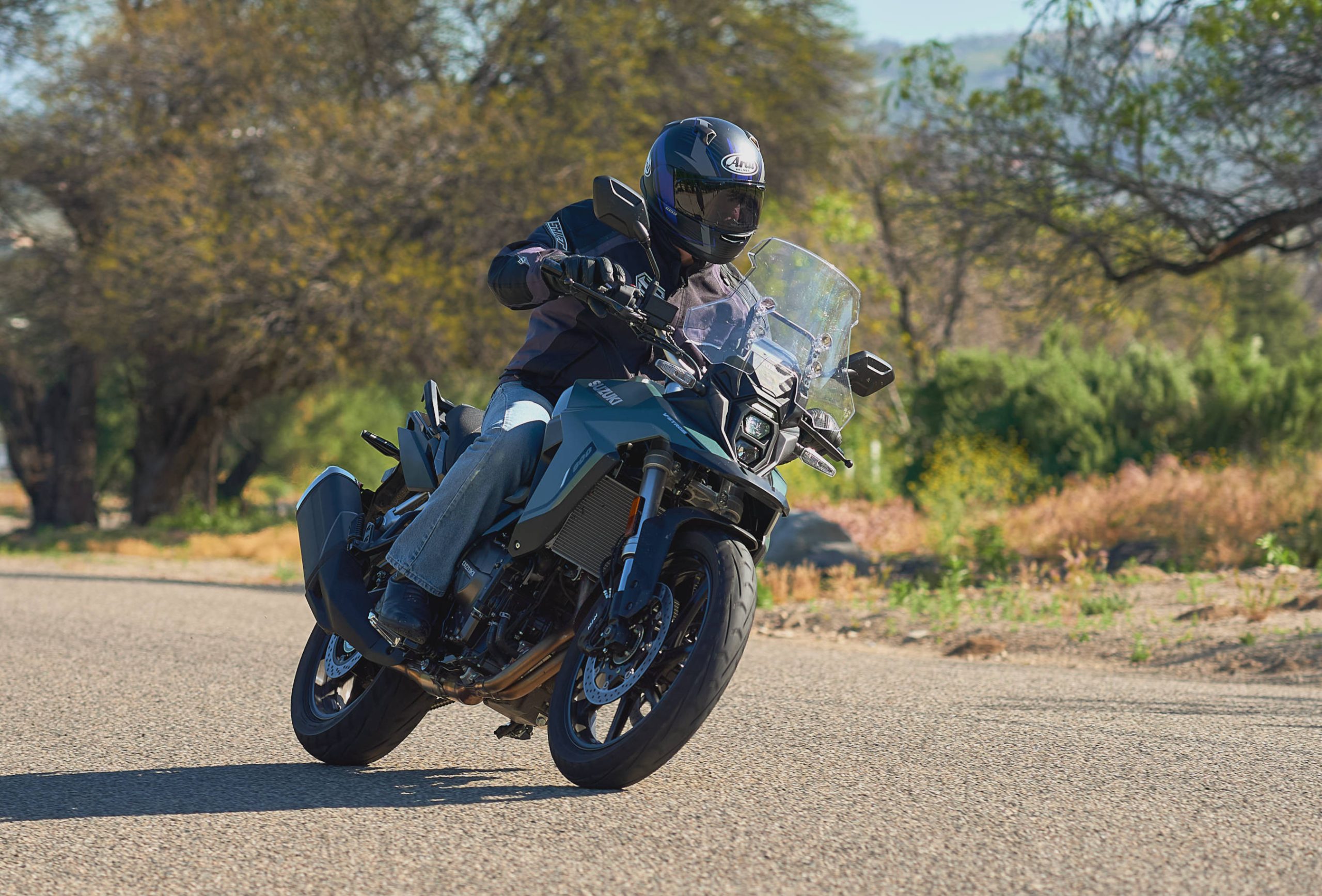
Suspension includes a 43 mm Showa fork with 5.9″ of travel and a Showa shock with the same 5.9″. The front fork is adjustable for spring preload, and is a well respected Showa SFF-BP (Separate Function Fork – Big Piston). The shock has a very convenient remote knob for tool-less spring preload adjustment, as well as rebound damping adjustment. The shorter suspension travel – roughly half-way between a traditional adventure model and a typical street bike – contributes to a much more manageable seat height of 32.5 inches that should allow even shorter riders to easily touch down.
The front brakes are very high quality radial-mount Nissin four-piston calipers operating on two 310 mm discs. The rear brake is another Nissin caliper operating on a single 260 mm disc. The front brake is a higher quality, more powerful brake than Suzuki puts on the more dirt-focused V-Strom 800 DE models.
Modern electronics and rider aids are present. Three different throttle maps range from Mode A with the sportiest response to Mode C, the softest. Traction control has three different settings allowing three different levels of intervention and wheel spin. Finally, this bike has Suzuki’s low rpm assist to help avoid stalling when pulling away from a stop.
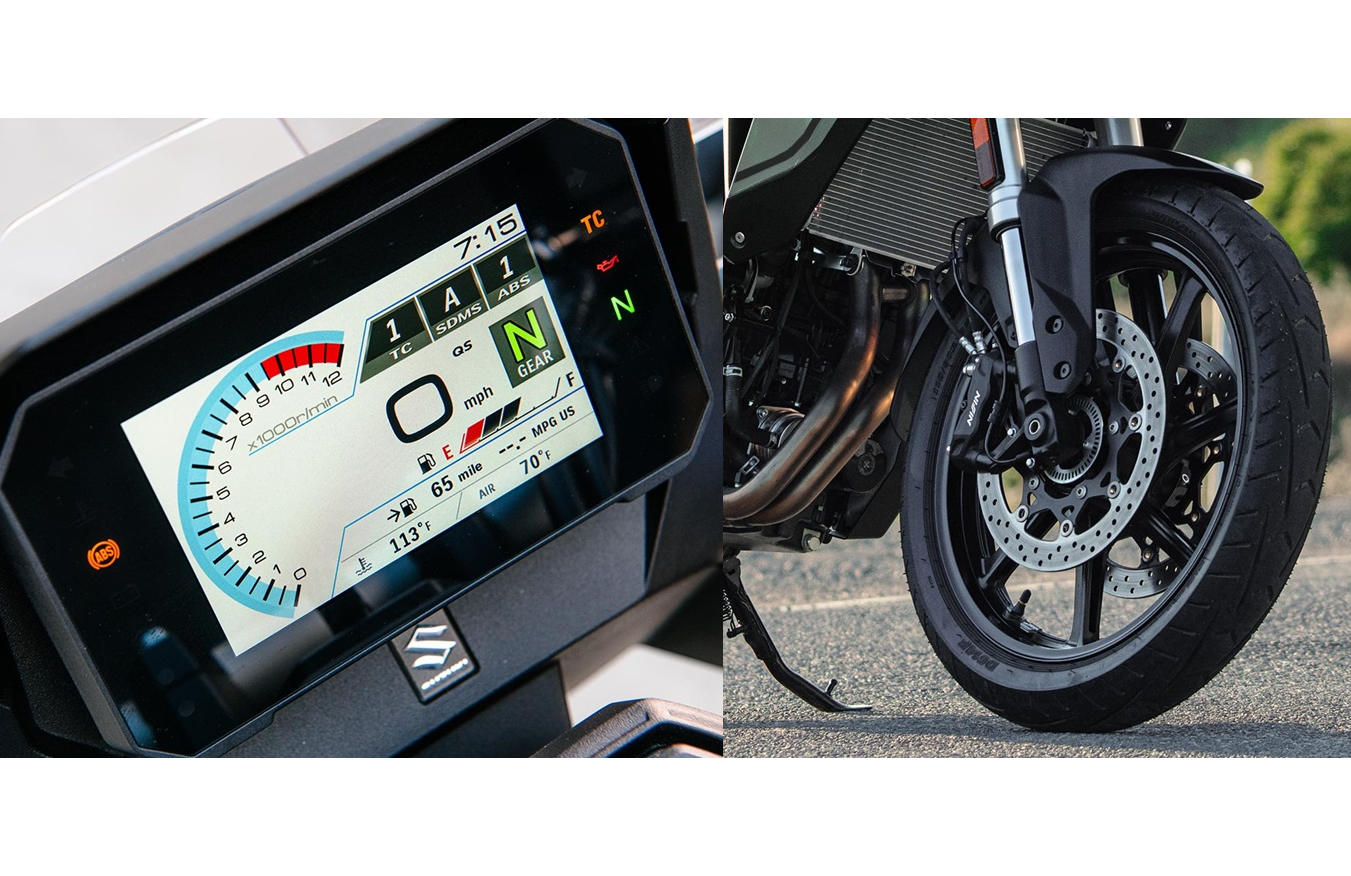
The V-Strom 800 has a comfortable seat and an upright rider triangle with a tiny bit of a forward lean compared to most adventure bikes. The wind screen is adjustable for three different heights, but must be done with tools in the garage. The screen sits rather far from the rider, and reminds one of a rally-style screen.
Within two blocks of riding the V-Strom 800, we fell in love with the motor. It has a very smooth, almost electric feel at low rpm and is very responsive without being snatchy. The bike pulls strongly through the mid-range before flattening out at higher rpms. On the freeway, as well as on the street, the bike seems to always sit in that sweet spot of mid-range power. The stock bike dynos with horsepower in the mid-to-upper 70s, comfortably more powerful than Kawasaki’s 650 models and even Yamaha’s MT-07 and related adventure model.
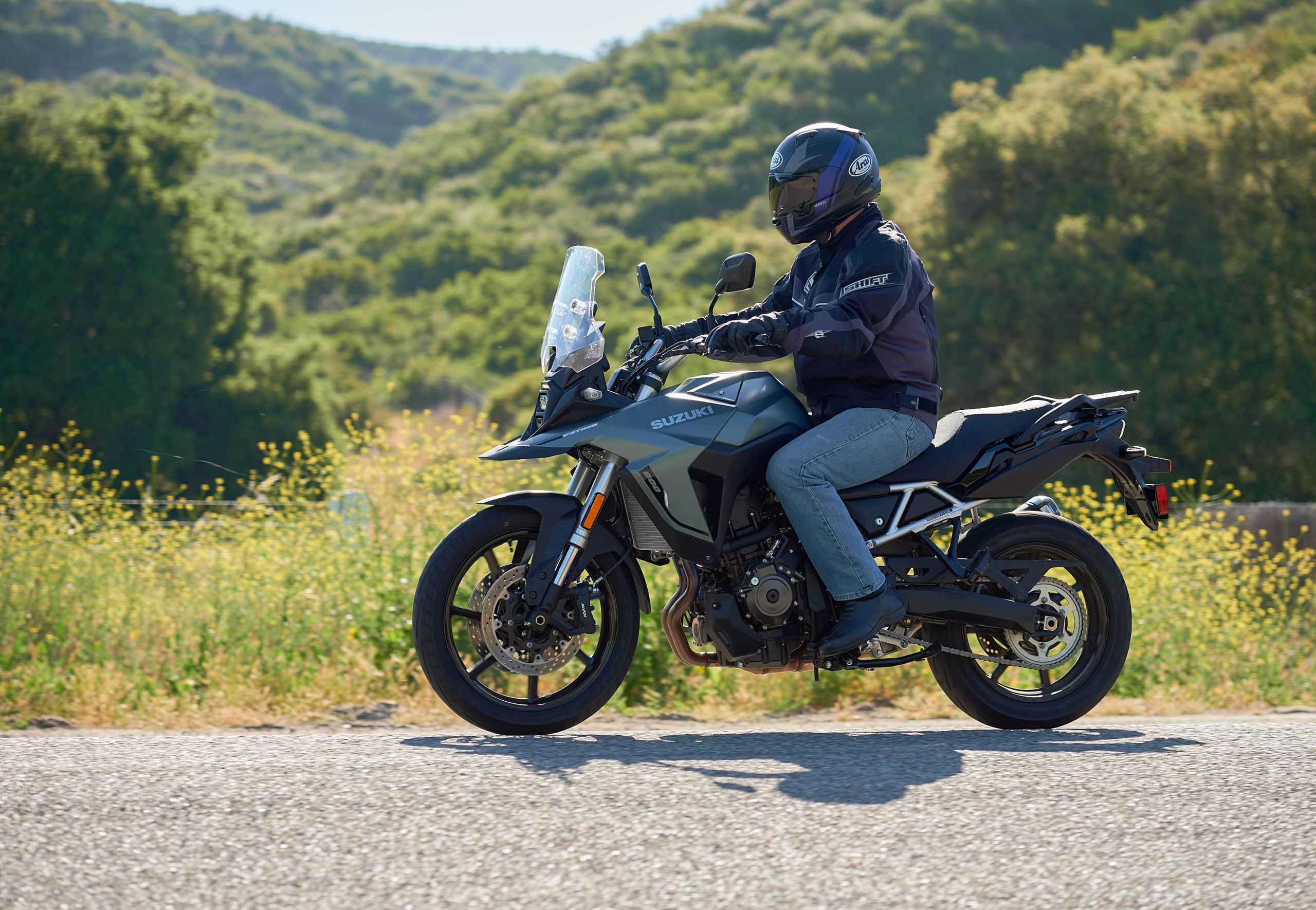
The engine characteristics couple with excellent handling, suspension and brake performance. The 19″ wheel doesn’t seem to impact handling much compared to sportier 17″ wheels found on some other bikes. The bike turns without a heavy gyro feel, and offers good traction and feedback through the stock Dunlop tires.
The slightly longer suspension travel (compared to other street bikes) is very welcome on most public roads that are less than perfect. The bike soaks up bumps well, but the suspension travel is short enough that the rider doesn’t feel much pitch when braking or accelerating. In short, this is a very fun bike on a twisty road that, in the hands of an experienced rider, can keep up with most sport-focused road bikes.
Like most Suzukis we have tested, the transmission was excellent. Gear changes, with an excellent quick shifter, were both positive and effortless. Gearing is relatively low, but sixth gear on the highway did not produce unpleasant vibration (although you know you are riding a parallel twin).
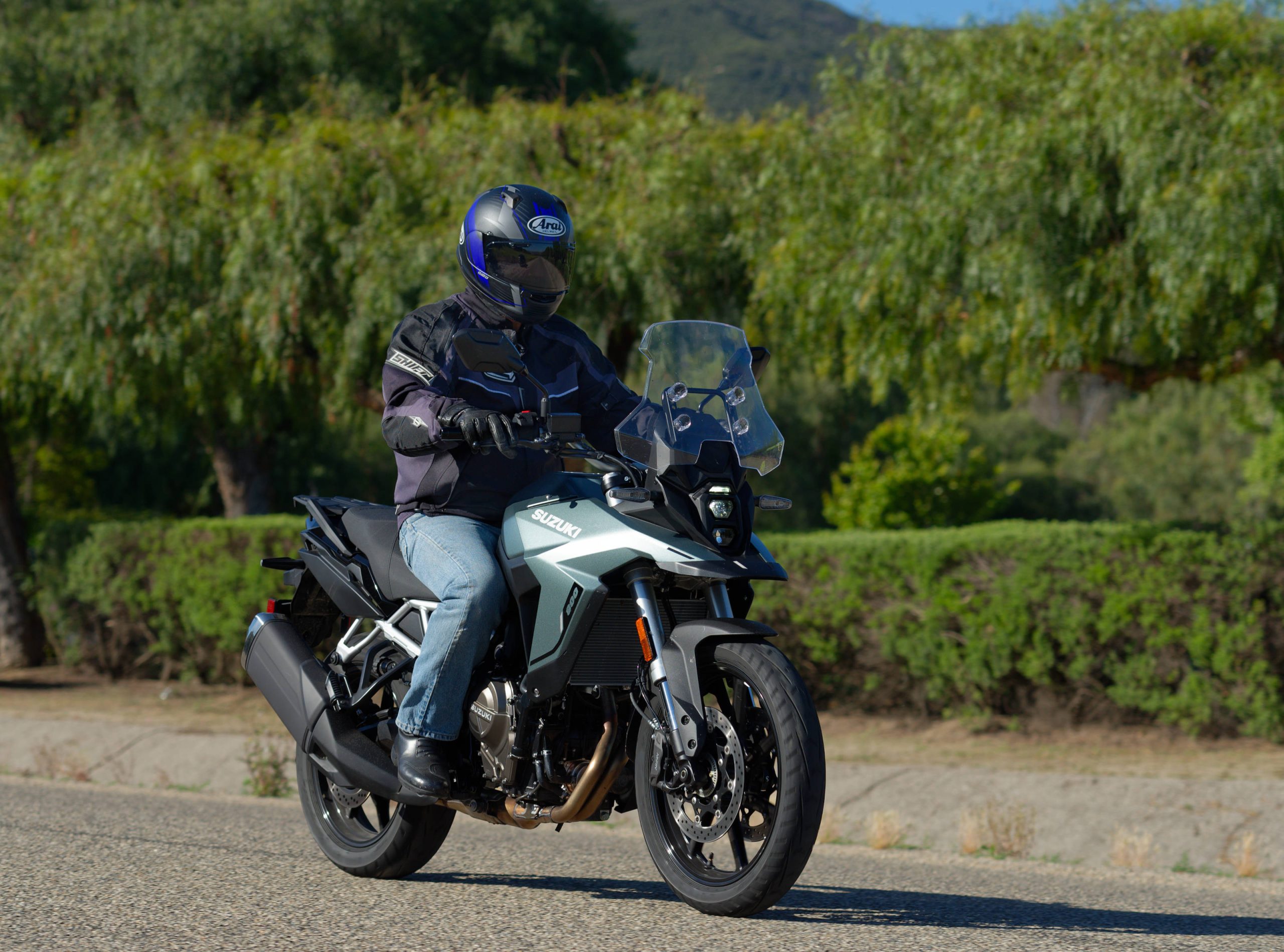
The 5.3 gallon fuel tank promises excellent range, and it is easy to exceed 50 mpg on this bike. We did find the fuel gauge on our test unit quite inaccurate, however, when it moved from an indicated 1/2 full to a flashing low fuel indicator too quickly.
Apart from the fuel gauge, our only complaint would be the windscreen. Our 5’11” test rider found the protection adequate, but too much wind buffeting at helmet level. Moving the windscreen to its highest position helped, but did not eliminate the problem. This certainly isn’t a deal breaker, and riders with different physical proportions might not have an issue. In any event, almost every adventure bike we have ridden has benefitted from an aftermarket windscreen,
The Suzuki V-Strom 800 turns out to be a very fun motorcycle to ride, while being comfortable and practical. Most riders purchasing adventure bikes never take them off-road, or do so rarely. The V-Strom 800 should be on their short list when they look for a new bike.
The U.S. MSRP of the 2024 Suzuki V-Strom 800 is $9,899. It is only available in the pictured Metallic Matte Steel Green. Take a look at Suzuki’s web site for additional details and specifications.






I’d like to see a front end unique to this model from the DE. The beak may aid in directing air to the radiator, but it seems like that would also result in reduced overall drag. Something a hint more like the Tiger/original Bandit S/original V-Strom with LEDs would be interesting…dual low-beams, please.
I would also like to see the front fairings of this ADV bike include nooks for additional lighting that is more tucked-in to the fairing.
(again, for aero)
I didn’t make it to the Suzuki truck stop nearest me this Spring. I hope to get a ride on this bike soon.
Drag? Whaddya think, it’s a rocket to Mars? The marketing silliness knows no bounds.
Yes. Aerodynamic drag. It’s a real thing…known to affect things such as rider rider comfort, noise, handling and tank duration.
Aside from tat, I just don’t like things added for aesthetics that add have no functional use…to say nothing of when they negate some degree of functional use.
You might say I don’t care for such silly marketing.
Motorcycles are notoriously draggy. There isn’t much opportunity for gaining efficiency through aerodynamics unless the riding position is dramatically changed (recumbent) and we start enclosing things. Things like beaks and windscreens are lost in the noise as long as the rider is sitting bolt-upright in the wind.
Funny thing about aero drag on a motorcycle, what is behind the rider can reduce drag also.
After modifying the wind screen to perfection on my V-Strom 650, I placed a large and long rectangular duffel bag directly against my back, and to the end of the rack, in line with the length of the bike and at steady 70 mph had a 1/8 less throttle position than without the bag.
Indeed that’s true, but aerodynamic implements of that type can really limit a rider’s choices (passenger carry, riding position, etc.) and then we’re back to the recumbent idea.
There was a radical body kit that Vetter experimented with (maybe sold?) that resulted in significant aero efficiency gains but look it up, you’ll see why few riders would want to ride it.
Strange duck this 800 V Strom. About 4 horsepower and 8 ft/ lbs more torque than the DL650 V Storm, not much to brag about for a engine much larger and 25 years newer. Considering the new 800 has a longer stroke that even the DL 1050 I would have expected much larger gains in low to mid range. The net yield on horsepower should have been 10 ponies above the current level to be competitive in this segment.
I’d wait to see what kind of efficiency it achieves. The 650 engine was a de-tuned sport engine and while it was efficient (I sometimes saw 60mpg on my 1st gen SV650) and more mild tune could result in even better efficiency. Case in point – a Honda NC700 is known to go 75mpg. While most would not describe its engine as “exciting” unless efficiency is what one gets excited about. HP/CC is fading as a key metric these days. Good riddance, I say.
If this is meant to be a mile eater, the 5 gal tank+good fuel mileage would address a common complaint about modern adv bikes – not enough range.
i find it amusing, many here want to criticize this new engine, when in the article it seems to say, quoting here “Within two blocks of riding the V-Strom 800, we fell in love with the motor. It has a very smooth, almost electric feel at low rpm and is very responsive without being snatchy. The bike pulls strongly through the mid-range before flattening out at higher rpms. On the freeway, as well as on the street, the bike seems to always sit in that sweet spot of mid-range power.” unquote. one would think the test rider would have pointed out how crummy then engine was if it really was as bad as the his 2 cents thinks? eh? 25 years ago, there were no Euro 2 compliant regulations, and one could build a dirty little engine that ran well. unlike today.
“…dirty little engine that ran well.” that’s why i named my kids ‘briggs’ and “stratton’.
If new engines didn’t have to make cleaner emissions than old engines, more people could be the result.
Part of the reason for increased CC is to be able to make the same power without while making cleaner emissions.
Until we change the fuel, there is probably not a lot of gain left in the ICE.
“Part of the reason for increased CC is to be able to make the same power without while making cleaner emissions.”
This is not bearing out in the results, though. This engine makes more power/torque across its rev range than the 650 v-twin it replaces as well as those of competing bikes. This engine, and many of the newer engines found in this class of bike are not tuned for maximum hp/cc, they’re tuned for broader power across the rev ranges people really ride in which also results in better efficiency in these ranges. While it doesn’t make the same ~100hp as KTM’s similarly sized P-twin, it isn’t intended to.
The hp/cc spec sheet race is coming to an end and I say good riddance.
My wife and I have 2016 V-Strom 650 Adventures. For the most part love the little bikes. Yes, at 6’1, tall seat the wind screen sucks making helmet noise so loud I have to wear ear plugs with my Shoie. Of course being a 650 it relies on revs to get any place in a hurry or passing on the freeway, especially with the new average speeds of 80 mph. On high mountain passes in the Sierra’s on slow switch backs I really felt the need for more cc’s for more bottom and mid range grunt. My wife often likes to pull away from stops hard and fast sometimes making me have to work to catch up. I tend to want to make my bike last rather than wringing it’s neck all the time. When I ride my Buel 1200 I effortlessly leave her far behind. I have thought the 650 needed to be about an 800 to be perfect without going to 1000-1200 cc’s which would kill gas mileage. We often get 70 mpg on long trips with fully loaded top and side cases. Seat comfort could be a lot better. My Buel has a Corbin Seat, what a world of difference!
This bike is a perfect balance for about everything a one-bike owner could ever want. By balance, I mean compromise. Most of us over-40 guys are 90% paved and 10% unpaved, and if the unpaved is not too gnarly, this very affordable, comfortable bike will work. I could see owning this bike for a decade or longer. In this era when several bikers can afford only one bike, this is it.
I can’t imagine having only one bike. But if I had to go there. It would be my KTM 300XC. I didn’t buy a street bike until I was in my late twenties. I’ve had dirt bikes since I was nine. No contest.
I’ve had one bike since I sold my Ninja 250 moving from CA to CO. ’07 FZ6 with custom thicker/higher/firmer seat and FZ6R bar (fixes weird bend of stock bar), and stainless brake lines – that’s it. It does everything I need, could be faster but is fast enough, cheapo suspension and brakes but what it has is fine at public-road (not necessarily the speed limit, mind you) speeds. It’s a quite competent motorcycle, and has required almost nothing beyond normal wear items, incredibly reliable. ~50k miles on it now.
Being a long term dirt biker who has grown up with suspension going from zero to hero. It’s hard for me to tolerate bad suspension. I rented an MT07 nine or ten years ago to ride around Germany and France. I really like the overall bike. But
the suspension and the rear ABS were parts non-gata. Both were up in my grill all the time. It’s sad that Yamaha does not make S models.
Yeah I had a great/modified suspension on the 250 actually. And I rode that more aggressively at the time as well. I just don’t think I push hard enough for it to really matter, and if suspension upgrades encouraged higher cornering speeds (which I could totally see) I’m reasonably sure that would be a bad idea, so it works out.
(I have looked at mods, cartridge emulators, Penske shock, etc. before deciding not to do all that.)
It’s just that since 1992 every bike I have owned has had a pretty decent minimum suspension, except the KLR that I got in leu of money for a debt repayment. I was always amazed that the KLR was so willing to offend with poor performance everything. But to their credit, they never do anything wrong or try to spit you off. Lately it seems that Kawasaki is testing just how bad a dirt bike the street crowd will tolerate. It seems they can add twenty pounds to the the thing with a color change and people will still flock to the door.
It’s funny, when I got married the KLR was the only two up bike that I owned. She knew nothing about motorcycles. But she hated the quality of the KLR immediately. After a tour of several dealers she chose the Multistrada, a bike that I thought had decent enough bones under all that hideous.
Aside from being pretty sensitive to rear preload, all Multistrada have easy remote preload adusters, the Multistrada actually works quite well. I’m on my third one, second if the one I own in Europe doesn’t count. And since 2004 so many astoundingly ugly motorcycles have been made that the Multistrada no longer stands out as a particularly ugly motorcycle.
The current 2008 Multistrada S has Ohlins suspension. It’s bigger upgrade than I expected over the Showa components on the original. Mainly for their ability to drink in train tracks and the like and not being nearly so sensitive to rear preload.
Mick, my wife would prefer serving me divorce papers vs. getting her on the back of my motorcycle. Even my therapists are flummoxed as to how to deal with this…
You can also get it in black, but you pay extra for a top box and handguards. Hopefully, the blue in the rest of the world will come in 2025.
I think I’m more excited about the review of the engine than the review of the bike as a whole. Hopefully Dirck gets his mitts on a GSX-8R and his enthusiasm for that machine is equal to the V-Strom (how Suzuki didn’t call this bike the “P-Strom” is one of life’s mysteries).
I am currently testing the GSX-8R. Stay tuned.
SWEEET. The writeups I’ve seen so far are very favorable. I don’t need a new bike but this one is on the very short list of bikes that I COULD go “well I better while it’s possible just on principle.”
I checked one of those out. My immediate issue is the not handle bars. Cast items bolted above the triple clamp? Me not get. Handlebars baby. It’s a choice thing.
I always wonder why manufacturers do that. If you’re going over the top triple clamp with controls, clip-ons vs tubular bars would seem to complicate things, give the owner less options and possibly add weight.
The simple answer is looks. I agree with you, adjustability should be prioritized. It’s amazing to me that motorcycles have always been so “one-size-fits-all”.
I agree about looks. When I first got my Ducati ST4 with its cast-alloy bars attached to the top yoke, I was so impressed, I told my mate I’d never go back to a bike with bicycle handlebars made of bent piping. Years on, that bike now has a raised one-piece bar conversion to suit my short and ageing body. The bars look rather crude and cheap but do the job far better!
Bolt-ons make it “easier” to convert to clip-ons later, no?
It’s odd how little changes in the street bike world. I replaced my two up, a 2004 Multistrada 1000 with a 2008 1100S model for the suspension upgrade. What is it? Well, it’s and adventure bike with sportier 17 inch wheels for street use. The 1000s cam profile makes the extra 100cc of the 1100 a moot point. Though the newer bike runs smoother at low RPM.
But I’m talking about a twenty year old bike here. It weighs less and even though it has an air cooled two valve engine, it makes more power. It is a torquey devil too.
Is the engine a gem? Yup! The 800cc version still sells like hot cakes in the Scramblers and the engine itself has powered zillions of popular bikes for decades. Even the current 800s makes about 73hp.
The best part is that you can find low miles used ones for sale at very attractive prices. Heck, my 2004 is for sale for well under half of what the above bike costs and it has zero buffeting issues.
Used air-cooled Ducati’s are cheap because they require an $800-$1200 valve service every 7,500 miles. Nice bikes but if you’re not equipped or capable of performing that service yourself, it’s hard to justify.
Only true if you max-out revs and power frequently, which really isn’t necessary to enjoy a torquey Ducati. Even the 4-valve Dukes need very little valve adjustment if they get sympathetic treatment. Same goes for cam-belt replacement, which is not necessary as frequently as the factory stipulated.
@Nick, would you buy a used air-cooled Duc with 20-30k miles on it from someone you didn’t know if they didn’t have receipts for the valve inspections?
Good point, but I’d factor-in an expert valve check and belt change as very high priority, followed by flooding all the electrical connectors with ACF50. Once done, I’d hope it was good to go!
Plenty of people do their own valve inspection and adjustments. If you have a bike with screw and locknut adjusters, you wouldn’t even have receipts for shims. Since my Ducati didn’t need any replacement shims I only had receipts for the belts and other service items. Still, a collector drove all the way up from Los Angeles to buy the bike off me.
The number of people (non-mechanics) who’ve pulled a cam and changed a valve shim has to be vanishingly small. I’d bet my house on it.
That’s unfortunate. It’s relatively easy to do but some bikes are easier to access than others. I guess some people are made of money and don’t mind having their bike off the road a few weeks waiting for a minimum wage technician to get around to messing with their pride and joy.
The hardest part of doing the valves is removing the gas tank, which is an issue on a lot of Ducatis. I just did the valves on the 2004. I had to set one of them, which I could really have left, but I was in there…
The gas tank takes me about half an hour to 45 minutes if I get interrupted.
People complain about the desmo valves. But most of those people have never tried. There are four valves on the whole bike and they are not that difficult to work on. The belts aren’t rocket sciance either.
The odd thing about the two valve Ducati is that it makes more than competitive power. I couldn’t believe how slow the 1000 V-Strom was when I rode it back to back with the 1000 Multistrada. Not even close. You would think anything with a four valve water cooled engine would easily out pace any air cooled two valve rig. But, think again. It’s seldom necessary to rev the thing past 6000rpm. It really is one of motorcycling’s great engines. Best of all it has two modes. On and off. And a cable throttle that you, yes you, can be trusted with.
I put 32,000 miles on my 93 Monster 900 and it didn’t require any valve adjustments but I did replace the cam belt (easy peasy). However, that bike was terribly uncomfortable and rattle-trap-noisy, handling was a joke as it oversteered so hard I would end up with forarm pump after a spirited ride through the canyons. My 690 Duke beats it everywhere on performance and comfort (sadly, not looks) and it hasn’t required a valve adjustment yet at 23,000 miles. I don’t ride it much though since my 91 K75S works excellent at both the canyons and the long highways, is super smooth and quiet and only needed two shims changed in the last 115,000 miles.
I was always amazed at how well the old Monsters sold. Total parts bin bikes whose parts really didn’t fit together all that well.
‘Barn door’ is the term that springs to mind for that screen. Having made three screens for various bikes to eliminate buffeting, this one is so obviously BAD!
Glad they made this model in a decent color.
Last years colors were as ugly as my ex-girlfriends soul.
Intresting and samo samo. Good motor ( 270 crank ) CRAP aerodynamics, geared short,( all stock gearing on any street bike would work much better a little taller ), too many brakes on pointy end, not inspiring weight ( until 1/2 fuel ), seat step too far foward, great TFT clocks, unique and eye catching color ( Frost Mold Pudding ), and sensible displacement. Did I mention CRAP wind screen ? It has potential, like some real estate.
They’ve been making V-stroms since early 2000’s and STILL cant figure out the windshield. I have a 2006 version, it required a Givi windshield and madstad mounting bracket to fix the buffeting issues. At least the motor and suspension appear to have gotten better…..
I had an 07 Wee-Strom and the stock windscreen was so bad it would literally blur my vision. Tried 4 different screens before I got the Madstad bracket. It made the screen tolerable but by no means “good.”
Had V-Strom 650, same year, I think, put on Kwaka Ninga 600 or 650 compound windscreen with Laminar Lip, PERFECT freeway smooth and quiet. Screens MUST curve back with air flow, be as close as possible to helmet, and straight across top edge. Stick a clipboard out a car window at speed straight up and down and see what happens.
Same here, I had a 2005 and the buffeting was bad. Seemed to be the only thing wrong with it.
The National Cycle V Stream shields work very well on the DL650, especially at elevated speeds.
There is no doubt that Suzuki builds excellent motorcycles. The only thing that turned me off was the curb weight. Yes, it’s a big tank, but if it was a gallon smaller, like the TransAlp’s tank, it’d only be 6 pounds lighter. Honda claims 459 pounds with a full tank. Adjust the Suzuki’s weight down for the reduced fuel load and it’s still some 25 pounds heavier.
I had an 07 Wee-Strom and the stock windscreen was so bad it would literally blur my vision. Tried 4 different screens before I got the Madstad bracket. It made the screen tolerable but by no means “good.”
Suzuki USED to build good bikes. The problem is that they are basically still making the same bikes from 20 years ago… and the rest of us are living in 2024.
How is this bike any less modern than any of the other P-twin bikes that have been released in the past few years?
Bob – the V-Strom 800 is an entirely new platform with an entirely new engine design. How is this “making the same bikes from 20 years ago”?
Are you sure you are living in 2024?
Uh, this is a new 270-degree-crank (so rides like a v-twin, not like traditional parallel-twins) motor that has been getting all kinds of rave reviews. You might want to ketchup, little tomato.
This ‘Strom feels no heavier than a Transalp (I’m six foot). If anything,it feels lighter. A fairer comparison: Transalp vs the more offroady ‘Strom 800 and, yes; the ‘Strom is a porker to push around and in tight traffic.
Here’s a thing about adv bike weight, though: Once you add the weight of even empty hardbags up high and far rear, a bit of extra weight down front near the mass center is no bad thing at all. And if you ride around with no luggage, why?? Get an 8S or R. Those are lighter, shorter, lower, tighter, narrower, more fun and just all around more sensible for riding around “naked” just for kicks.
IF you take offroading your ADV seriously; less weight becomes more important. Then, you likely use light softbags, break the handle off your toothbrush and ride without socks to save grams etc. But for this sort of “all road” bike, chances are most people will not find it problematically heavy anywhere outside the spec sheet. It’s still plenty lighter than all the 1000+ advs; and with a COG and seat height much, much lower than virtually all of them, it’s a remarkably balanced all-uses bike, which gives up very little, in all areas, to more specialized rides.